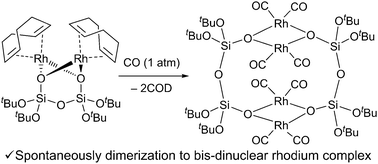Multinuclear rhodium complexes supported by tetra-tert-butoxy disiloxide ligand: synthesis, structure, and reactivity†
Abstract
Rhodium siloxide complexes have been used as homogeneous catalysts and model compounds for silica-supported metal catalysts. However, rhodium complexes with multidentate siloxide ligands have rarely been prepared. In this study, a dinuclear rhodium complex supported by a bidentate tetra-tert-butoxy disiloxide ligand, {Rh(COD)}2{μ-(OSi(OtBu)2)2O} (3) (COD = cyclooctadiene), was synthesized and its basic reactivity was elucidated. When 3 reacted with carbon monoxide, a dinuclear rhodium carbonyl complex, {Rh(CO)2}2{μ-(OSi(OtBu)2)2O} (A), formed as an intermediate, which produced a bis-dinuclear rhodium carbonyl complex, [{Rh(CO)2}2{μ-(OSi(OtBu)2)2O}]2 (4), by spontaneous dimerization. The dimerization of A could be attributed to the relatively weak electron-donating ability of the tetra-tert-butoxy disiloxide ligand, suggesting that substituents on siloxide ligands exert a significantly large effect on the formation of rhodium siloxide complexes. In addition, the reaction of 3 with trimethylphosphine (PMe3) afforded different dinuclear rhodium complexes, {(PMe3)Rh(COD)}2{(OSi(OtBu)2)2O} (5), {(PMe3)2Rh}{Rh(COD)}{μ-(OSi(OtBu)2)2O} (6), and {Rh(PMe3)2}2{μ-(OSi(OtBu)2)2O} (7), depending on the reaction temperature and the equivalent of PMe3 used, indicating that the substitution reaction of COD by PMe3 proceeds in a stepwise manner. Understanding the basic reactivity of these rhodium siloxide complexes may contribute to the development of silica-supported metal catalysts.



 Please wait while we load your content...
Please wait while we load your content...